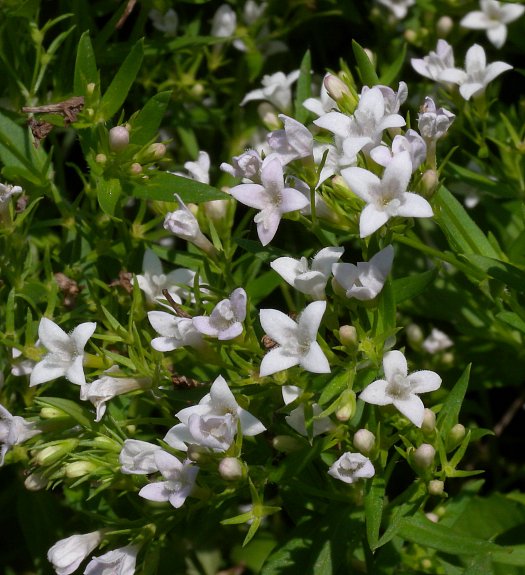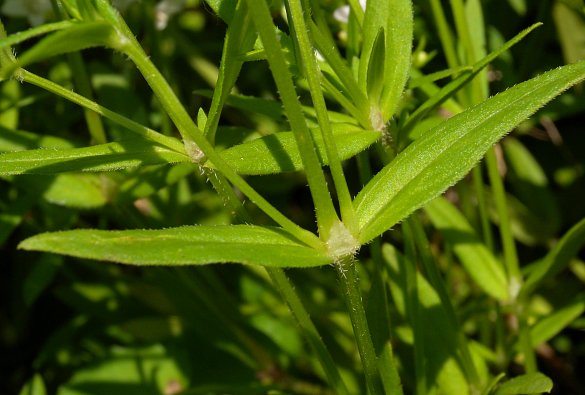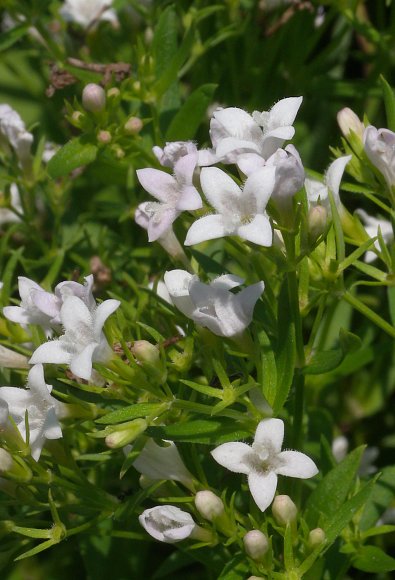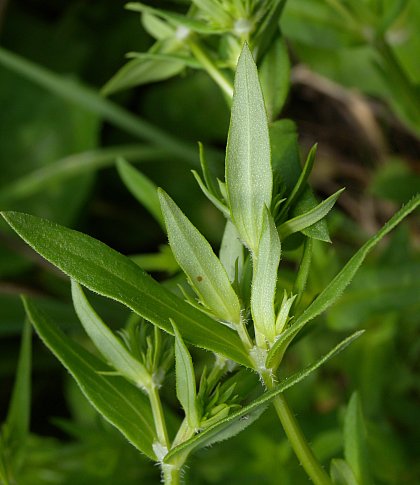Description: This herbaceous perennial wildflower is 4-10" tall and more or less erect. A small rosette of basal leaves may be produced, but it withers away before the flowers bloom. The margins of these basal leaves, when present, are hairless. Multiple flowering stems are produced that often branch. These stems are light to medium green, 4-angled, and either hairless or slightly hairy along their angled margins. Pairs of opposite leaves occur at intervals along each stem. These leaves are about ½–1" long and less than ¼" across; they are medium green, lanceolate-oblong or linear-lanceolate, smooth or ciliate along their margins, and single-veined. Secondary leafy stems often develop from the axils of the opposite leaves along the primary stem. The upper stems terminate in small flat-headed clusters of flowers.

Individual flowers are about ¼" across, consisting of a tubular corolla with 4 spreading lobes and a green calyx with 4 linear-lanceolate teeth. The color of the corolla can vary from pale purplish pink to white; there are conspicuous hairs along its throat. The flowers of Long-Leaved Bluets are dimorphic: some flowers have long fertile styles and short aborted stamens, while other flowers have short aborted styles and long fertile stamens. Each fertile style has a pair of flattened stigmata at its apex. The blooming period occurs from late spring to mid-summer and lasts about a month. The flowers are replaced by globoid 2-celled seed capsules that are a little shorter than the teeth of their calyces. Each cell of a seed capsule contains several small seeds. The root system consists of a small crown with long fibrous roots underneath. This wildflower spreads into new areas by reseeding itself.

Cultivation:
The preference is full or partial sun, mesic to dry conditions, and a
rather sterile soil that is rocky or gravelly. This species will adapt
to rock gardens and it is not difficult to cultivate, however it
doesn't tolerate much competition from taller and more aggressive
ground vegetation.
Range & Habitat:
The native Long-Leaved Bluets occurs occasionally in northern and
southern
Illinois, while in the central section of the state it is largely
absent (see Distribution
Map). Habitats include dry gravel prairies, hill prairies,
rocky glades, thinly wooded bluffs, and rocky upland woodlands. This
wildflower is normally
found in high quality natural areas.

Faunal
Associations:
The flowers are pollinated primarily by small bees, including Halictid
bees (Lasioglossum spp., Halictus spp.,
etc.), masked bees (Hylaeus
spp.), little carpenter bees (Ceratina spp.),
and mason bees (Hoplitis
spp.). These insects suck nectar and collect pollen from the
flowers.
The caterpillars of a small moth, Thyris maculata
(Spotted Thyris), feed on the leaves of Houstonia spp.
(Bluets). The foliage is not known to be toxic, therefore it may be
eaten occasionally by the Cottontail Rabbit and other mammalian
herbivores.
Photographic Location:
The wildflower garden of the webmaster in Urbana, Illinois.

Comments: This is a dainty plant that produces abundant small flowers if it receives some sunlight. Long-Leaved Bluets is smaller in size than Houstonia purpurea (Broad-Leaved Bluets), but larger in size than several other bluets, including Houstonia caerulea (Quaker Ladies) and Houstonia pusilla (Small Bluets). Long-Leaved Bluets is very similar in appearance to Houstonia canadensis (Canada Bluets); some authorities consider the latter species to be a variety of the former, or Houstonia longifolia ciliata. Canada Bluets is supposed to have more persistent basal leaves with ciliate margins, flowering stems that are fewer in number and less branched, and slightly longer corolla lobes. Because the ranges of these two species overlap and they may intergrade, it is not always possible to reliably assign field specimens to one species or another. A scientific synonym of Long-Leaved Bluets is Hedyotis longifolia.